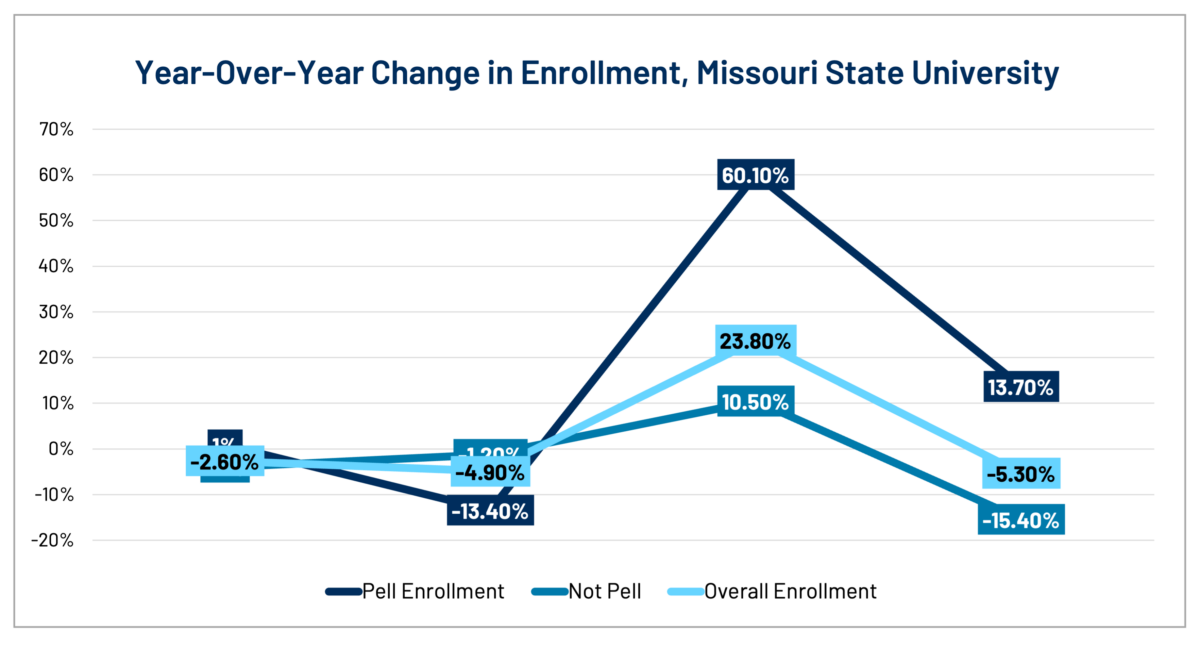Many enrollment offices are facing the challenge of recruiting the students of tomorrow to preserve the long-term success of their institution. In response, they have had to shift their strategic plans and find innovative ways to meet the needs of a changing student population.
Two enrollment leaders — Lauren Keeling, Interim Vice President of Enrollment and Marketing at Bellarmine University and Matt Magruder, Director of Admissions at Missouri State University — share how they approached recruiting a higher percentage of Pell students with new financial aid programs, and how marketplace data helped them achieve their goals.
Using Financial Aid Awarding to Grow Pell Enrollment
At Missouri State University, a large public institution with 80% in-state students, the Pell-qualifying population had been declining since its peak at 40% of their 2010 freshman class to just 29.6% in 2021. But in 2023, they experienced an impressive 60% spike from the previous year. Then, despite the enrollment difficulties of 2024, they were still up another 13.7%, which largely offset their losses with more affluent students.

Magruder attributes a big part of this growth to Missouri State’s ‘MoState Access Award’, which was instituted during the 2023 cycle and guarantees the gap between a student’s Pell aid and tuition cost will be covered by federal, state or institutional aid. But implementing this big change wasn’t easy. He explained how much work it took to convince decision makers at Missouri State that this was the right move.
“This wasn’t easy for us. It took two years in admissions advocating for this. The reason we kept trying was because we believed in it. If you believe in something, if you believe it’s good for the institution and for students, don’t give up on it.” – Matt Magruder
The program resulted in Missouri State’s Pell qualifying population reaching a new high of 41.8% of their 2024 freshman class. This ultimately led to a 17% increase in freshman students of color, helping them meet their diversity goals.
Due to the delay in ISIR data last cycle, the success of this financial aid program wouldn’t have been possible without the help of consumer data as an approximation. Magruder’s team used MARKETview’s consumer income brackets to identify which students were likely to be Pell eligible and communicated with them ahead of time about the MoState Access Award program. Their proactive messaging efforts resulted in their institution outperforming MARKETview’s Public Cohort in terms of yield rate for the under 50k household income bracket by over 8 percentage points (pp).
Recruiting and Investing in the Students of the Future
Bellarmine, a small private Catholic Institution in Kentucky, was already dealing with declining budgets, shifting affluence of the nearby Catholic high school market and increasing competition from big state schools. When their team looked at MARKETview projections of the coming demographic cliff, they realized they were not going to be able to sustain the enrollment numbers they needed to meet their budget goals in the years to come.
Keeling’s team realized they needed to change their recruiting strategy for the low-income students that historically made up a large proportion of their student population. Similar to Missouri State University, Bellarmine employed a Pell gap filler program called ‘The HOPE Kentucky Scholars Program’ to help increase their Pell-eligible student population. This led to huge success in 2023, with a 2 pp jump in overall yield rate and overall improved yield with students from low-income households. They also saw increases across the board in enrollment, Pell enrollment, diversity, first-generation student enrollment and a 9% increase in total NTR.

To support these efforts, the enrollment marketing team adjusted their student outreach using MARKETview’s ability to identify students that are “Likely Pell” to deliver early and targeted messaging to students in the inquiry pool about the Hope Kentucky Scholars Program.
But Bellarmine’s work didn’t end at enrollment. Their team wanted to make sure the low-income students they invested in recruiting would also stay for all four years — it’s well known that these students don’t typically retain as well. Keeling explained how her team achieved that goal.
“It was more than just an enrollment effort. We had to make sure the campus experience supported all our students, but particularly the most vulnerable.” – Lauren Keeling
The Bellarmine team invested in more faculty advisors, a peer coaching program, professional advisors and career coaches to make sure their students felt valued on campus and empowered to succeed.
If you enjoyed this post, keep an eye out for Part 2 of this blog coming later this month, where we’ll explore the data insights that Mount Saint Mary’s University uncovered about their Pell cohort using MARKETview data.
Interested in learning more about how MARKETview can help you identify the Critical Elements to achieving your institutional goals? Sign up for a live demo with our team today.
